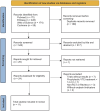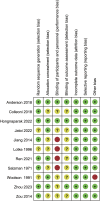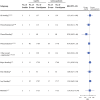Aspirin Is as Effective and Safe as Oral Anticoagulants for Venous Thromboembolism Prophylaxis After Joint Arthroplasty: A Systematic Review and Meta-Analysis of Randomized Clinical Trials
- PMID: 39836735
- PMCID: PMC11949201
- DOI: 10.2106/JBJS.24.00946
Aspirin Is as Effective and Safe as Oral Anticoagulants for Venous Thromboembolism Prophylaxis After Joint Arthroplasty: A Systematic Review and Meta-Analysis of Randomized Clinical Trials
Abstract
Background: Joint arthroplasty effectively treats osteoarthritis, providing pain relief and improving function, but postoperative venous thromboembolism (VTE) remains a common complication. This study therefore assessed the effectiveness and safety of aspirin compared with oral anticoagulants (OACs) for VTE prophylaxis after joint arthroplasty.
Methods: A systematic review and meta-analysis was performed by searching PubMed, Embase, the Web of Science, and the Cochrane Library for randomized controlled trials (RCTs) up to May 14, 2024, that compared the effect of aspirin versus OACs on VTE prophylaxis in adults undergoing joint arthroplasty. Data extraction followed the PRISMA guidelines. Two independent researchers conducted the literature searches and data extraction. A random-effects model was used to estimate effects. The primary outcome was the incidence of VTE, including deep vein thrombosis (DVT) and pulmonary embolism (PE); secondary outcomes included bleeding, wound complications, and mortality.
Results: The meta-analysis included 11 RCTs with a total of 4,717 participants (55.1% female) from several continents. The relative risk (RR) of VTE following joint arthroplasty was 1.11 (95% confidence interval [CI], 0.93 to 1.32) for aspirin compared with OACs. Similar results were observed for DVT (RR, 1.12; 95% CI, 0.90 to 1.40) and PE (RR, 1.18; 95% CI, 0.51 to 2.71). There were no significant differences in the risks of bleeding, wound complications, or mortality between patients receiving aspirin and those receiving OACs. Subgroup analyses considering factors such as study region, type of joint surgery, type of VTE detection, year of publication, use of mechanical VTE prophylaxis, aspirin dose, type of OAC comparator, study quality, and funding also found no significant differences in VTE incidence between aspirin and OACs. The overall quality of evidence for VTE and DVT outcomes was high.
Conclusions: Based on high-quality evidence from RCTs, aspirin is as effective and safe as OACs in preventing VTE, including DVT and PE, after joint arthroplasty, without increasing complications.
Level of evidence: Therapeutic Level I . See Instructions for Authors for a complete description of levels of evidence.
Copyright © 2025 The Authors. Published by The Journal of Bone and Joint Surgery, Incorporated.
Conflict of interest statement
Disclosure: This work was supported by Enze Medical Center (Group) Scientific Research (No. 23EZA04) and Zhejiang Medicine and Health Scientific Research Project (No. 2024KY531). The funders had no role in the study design, data collection and analysis, decision to publish, or manuscript preparation. The Disclosure of Potential Conflicts of Interest forms are provided with the online version of the article ( http://links.lww.com/JBJS/I369 ).
Figures






Similar articles
-
Pharmacological interventions for preventing venous thromboembolism in people undergoing bariatric surgery.Cochrane Database Syst Rev. 2022 Nov 22;11(11):CD013683. doi: 10.1002/14651858.CD013683.pub2. Cochrane Database Syst Rev. 2022. PMID: 36413425 Free PMC article.
-
Interventions for implementation of thromboprophylaxis in hospitalized patients at risk for venous thromboembolism.Cochrane Database Syst Rev. 2018 Apr 24;4(4):CD008201. doi: 10.1002/14651858.CD008201.pub3. Cochrane Database Syst Rev. 2018. PMID: 29687454 Free PMC article.
-
Pentasaccharides for the prevention of venous thromboembolism.Cochrane Database Syst Rev. 2016 Oct 31;10(10):CD005134. doi: 10.1002/14651858.CD005134.pub3. Cochrane Database Syst Rev. 2016. PMID: 27797404 Free PMC article.
-
Anticoagulants (extended duration) for prevention of venous thromboembolism following total hip or knee replacement or hip fracture repair.Cochrane Database Syst Rev. 2016 Mar 30;3(3):CD004179. doi: 10.1002/14651858.CD004179.pub2. Cochrane Database Syst Rev. 2016. PMID: 27027384 Free PMC article.
-
Antiplatelet agents for the treatment of deep venous thrombosis.Cochrane Database Syst Rev. 2022 Jul 25;7(7):CD012369. doi: 10.1002/14651858.CD012369.pub2. Cochrane Database Syst Rev. 2022. PMID: 35876829 Free PMC article.
References
-
- Piple AS, Wang JC, Kang HP, Mills ES, Mayfield CK, Lieberman JR, Christ AB, Heckmann ND. Safety and Efficacy of Rivaroxaban in Primary Total Hip and Knee Arthroplasty. J Arthroplasty. 2023. Aug;38(8):1613-1620.e4. - PubMed
-
- Runner RP, Shau DN, Staley CA, Roberson JR. Utilization Patterns, Efficacy, and Complications of Venous Thromboembolism Prophylaxis Strategies in Revision Hip and Knee Arthroplasty as Reported by American Board of Orthopaedic Surgery Part II Candidates. J Arthroplasty. 2021. Jul;36(7):2364-70. - PubMed
-
- Faour M, Piuzzi NS, Brigati DP, Klika AK, Mont MA, Barsoum WK, Higuera CA. Low-Dose Aspirin Is Safe and Effective for Venous Thromboembolism Prophylaxis Following Total Knee Arthroplasty. J Arthroplasty. 2018. Jul;33(7S):S131-5. - PubMed
Publication types
MeSH terms
Substances
LinkOut - more resources
Full Text Sources
Medical
Research Materials

